- solen.sk - Warts and their treatment in children, doc. MUDr. Tibor Danilla, CSc., Children's Dermatovenerology Clinic, Faculty of Medicine, Charles University in Bratislava.
- venerologie.cz - Human papillomavirus (Verruca vulgaris)
- patient.info - Seborrheic warts
- patient.info - Warts and verrucae
- dermatologyadvisor.com - Dermatology
What are warts and how to protect yourself from transmission (+ types of warts)
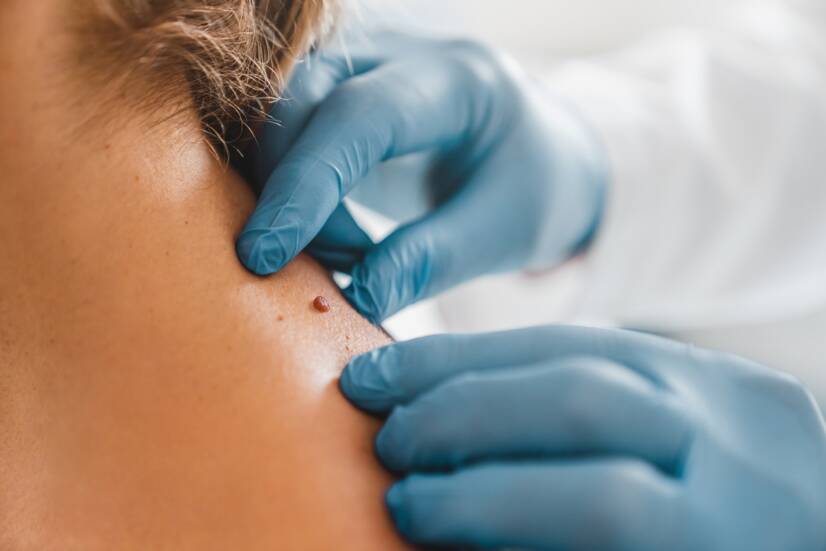
Warts are non-cancerous infectious growths on the skin. They are not pretty and can make life uncomfortable and cause pain. They occur quite often at any age. Why do they occur, what causes them and how to get rid of them?
Most common symptoms
Characteristics
Warts are not harmful and most people will develop them at least once in their lifetime.
They are most commonly caused by papillomavirus infection. They occur in both adults and children.
There are several types of warts. Each type of these viruses manifests itself differently in humans. They may appear as common warts on the skin, papillomas at the interface between the skin and mucous membranes or condylomas on the genitals. Condylomas are also involved in cancer.
Non-genital warts often occur in children and adolescents on the hands, face and feet. Anogenital warts are not common in children. They are considered sexually transmitted infections.
This skin disease affects one in ten people.
Warts are most commonly found on the hands, feet, fingers, neck, sometimes on the hands and feet at the same time, in the genital area, in the hair, on the face, on the nose, in the armpits, but also on other parts of the body and mucous membranes.
In most cases they are not painful and may not cause any serious problems. Sometimes they are just a cosmetic problem. They do not look nice and can be unpleasant for some people.
Painful warts occur on sensitive areas such as the foot or fingertips. On the foot, they cause pain due to excessive pressure. On the toes, they interfere with fine motor skills.
Most warts are contagious. They are transmitted by direct contact with an infected person. They can also be transmitted by indirect contact, for example by an infected towel or by going to the swimming pool.
Close skin-to-skin contact is necessary for transmission. Infection is transmitted more quickly if the skin is broken. Transmission can also occur if the skin is wet and comes into contact with rough surfaces, for example in swimming pools.
Causes
Warts are caused by the human papillomavirus (HPV). The human papillomavirus attacks the cells of the uppermost layer of the skin or mucous membranes and causes them to change. This viral infection of the skin causes a reaction on the skin. It manifests itself in the form of small skin bumps that form warts.
They occur anywhere on the body, most commonly on the hands and feet. Their size varies from 1 mm to more than 1 cm. They appear singly, as two warts or several warts in one place. These viruses cause a subsequent slow multiplication of cells on the upper layer of the skin. The multiplication may be slow or, in some cases, rapid.
Warts can persist for varying lengths of time, months to years, or heal without subsequent scarring.
There are more than 100 different types of HPV virus known. Warts are most commonly caused by HPV types 2, 3 and 4. Other types can cause genital warts or even cancer, most commonly of the cervix.
The cause of warts is infection with the HPV virus.
It is transmitted by direct contact with an infected person, indirect transmission from an infected site, or the possibility of transmission from an infected mother during childbirth.
HPV viruses are divided into cutaneous and mucosal types.
Cutaneous types of HPV viruses are the cause of warts.
Some people get one wart, some get more. It also depends on their immunity. When the immune system is weakened, the body cannot fight warts. There is a massive seeding of more warts, which are already difficult to remove.
Read also:
What is HPV and the HPV vaccine? It's not just about warts...
Symptoms
The first sign of infection is the appearance of warts in the form of blisters. This is the characteristic and most common symptom.
The appearance of warts can take several months. It is manifested by the slow enlargement of a small growth that resembles a rash with the same skin colour. This begins to peel a little after a few weeks. Sometimes they do not cause any symptoms and disappear without treatment.
Warts are divided into several types according to their symptoms:
- Common warts
- Flat warts
- Plantar warts
- Filiform warts
- Seborrheic warts
- Contagious warts
- Anal and genital warts
1. Common warts
Common warts (Verruca vulgares) are most commonly found in children and adolescents aged 5-20 years, sometimes in people in their 30s. They are round, raised in shape, 1 mm to 1 cm in diameter, and greyish-yellow in colour. They are rough and hard to the touch. Sometimes they may be cracked with minor scaling. The cracks may be painful and bleed. Smaller warts sometimes develop around the first wart.
They enlarge over a few weeks to months. They are most common on the hands, palms and around the nails. They can spread to other parts of the body. They usually disappear within 2 years.
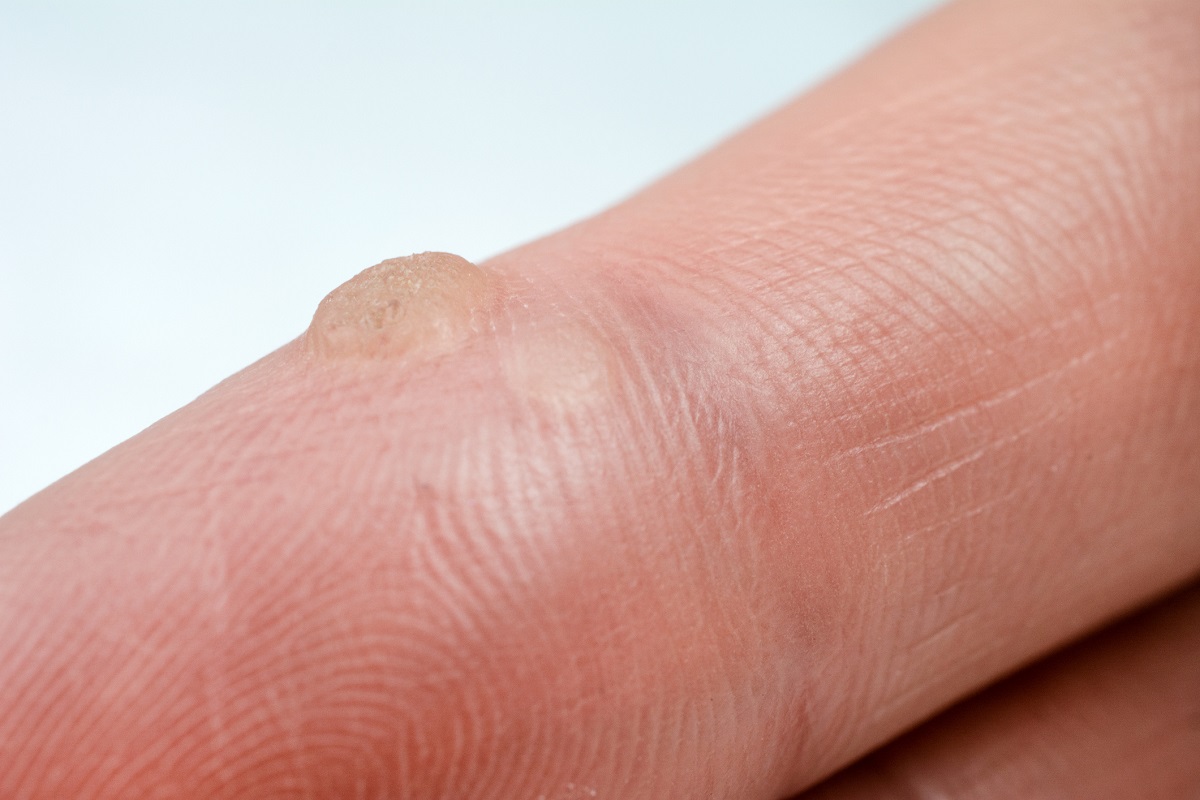
2. Flat warts - Verruca planae
They occur mainly in children and adolescents, very rarely in adults.
They are smaller than common warts. They are 1-4 mm in diameter, oval in shape, pinkish, greyish, yellowish brown, dark brown, brownish red or slightly different skin colour.
They appear as small flat blisters with a rough surface with slight scaling.
They occur in large numbers, most commonly on the head, neck, backs of hands and limbs.
They are often itchy. Especially in children, they scratch easily. They can spread to other parts of the skin. They heal spontaneously after months or years without scarring.
3. Plantar warts - Verruca plantaris
They are common in the adult population. They occur on the feet, especially in areas of increased pressure when walking, such as the heel. Gradual pressure on the wart causes it to grow deeper into the skin. Therefore, it takes longer to be noticed.
Initially, the growth is flat with a smooth surface. Only over time does it rise above the level of the skin, where it hardens and roughens.
Sometimes a hardened ring resembling a blister forms around the wart. Occasionally, small dark dots appear in the centre of the wart, caused by minor bleeding. Therefore, after scratching, localised light bleeding occurs.
This type of wart is very painful. The pain causes a problem when walking. Warts can cluster in groups. In this case, they are called mosaic warts.
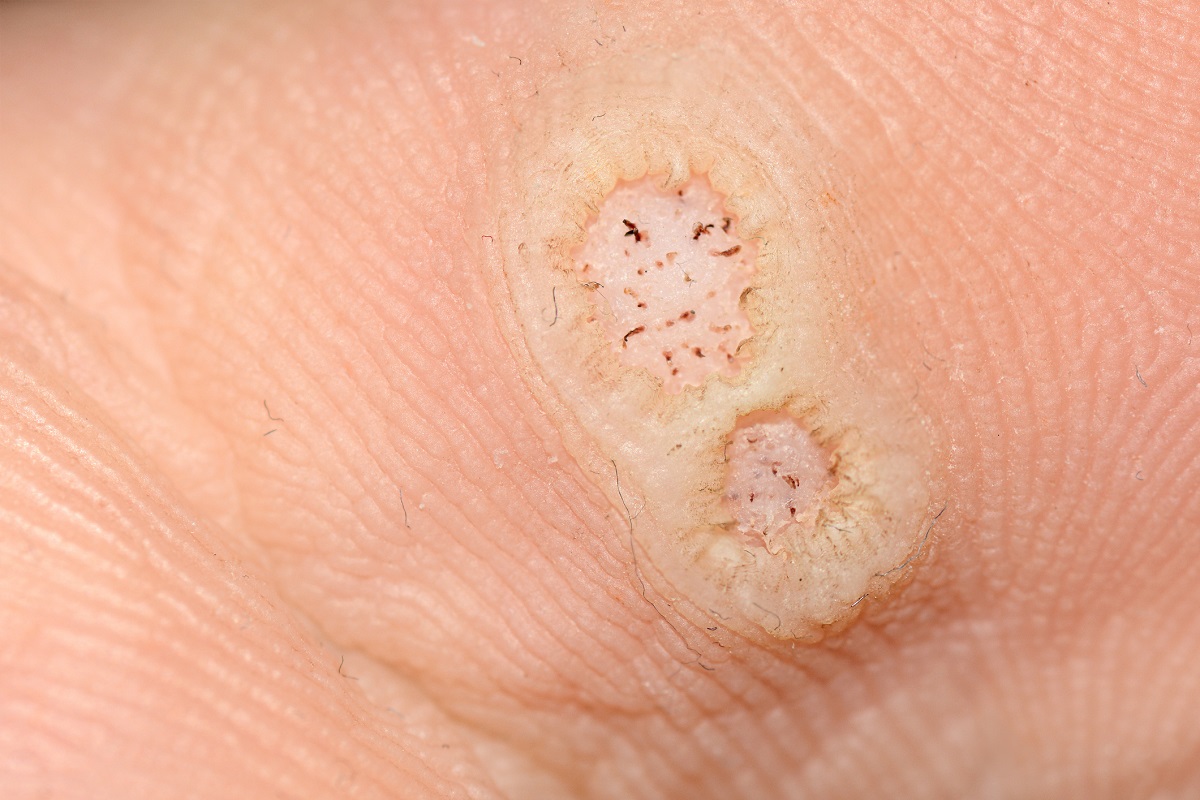
4. Filiform (thread-like) warts - Verruca filiformis
Filiform warts are common in adults, but can also occur in children. They occur in areas where the skin is thin and delicate, especially the eyes, eyelashes and lips. Their shape is narrow and oval. They protrude above the level of the skin. They are often scratched and distorted, especially when shaving. Scratching causes subsequent bleeding and their surface becomes hard and corroded.
This type spreads rapidly and multiplies into larger groups.
5. Seborrhoeic warts
Seborrhoeic warts are known as seborrheic keratoses or age warts.
They are non-infectious, not caused by a virus. They are non-cancerous growths on the skin. They look like a greasy, scabby patch adjacent to the skin. They are round or oval in shape. They can range in size from 1 cm to several centimetres. Their colour varies. They are usually dark brown or black. They do not usually require treatment.
They occur mainly around the age of 40, anywhere on the body.
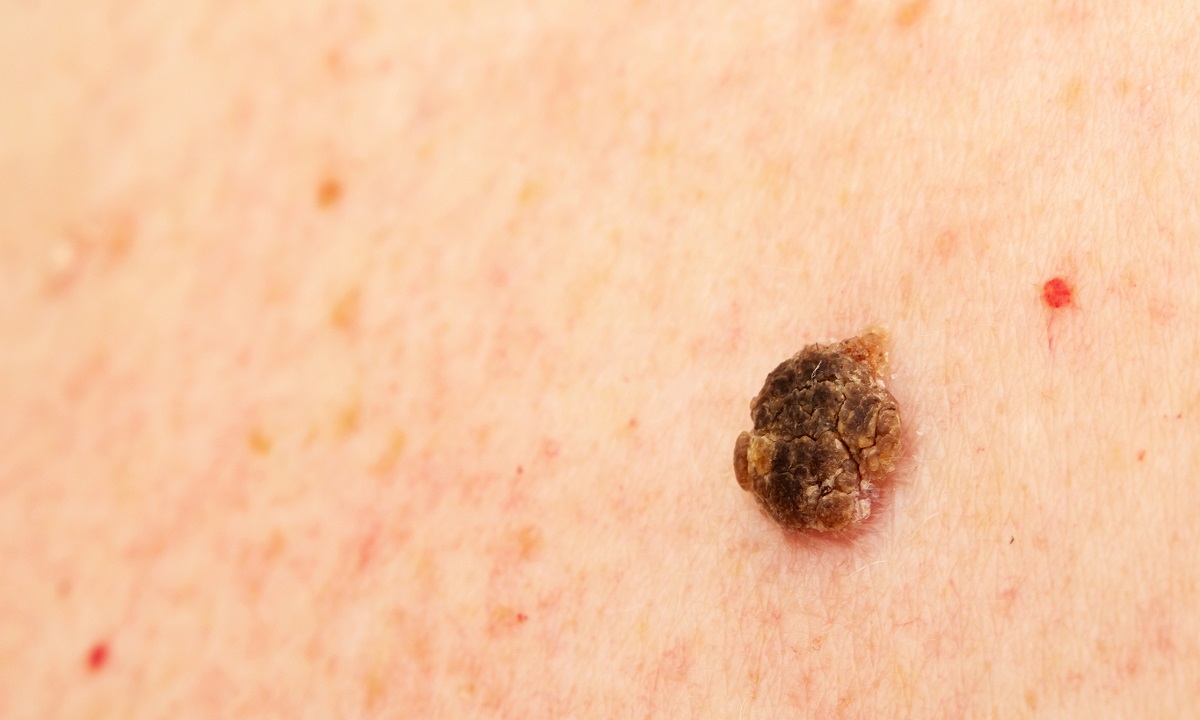
6. Contagious warts
Contagious warts are caused by the virus proxivirus mollusi or molluscum contagiosum. Transmission occurs through sexual contact, intimate contact with an infected person. Warts can occur anywhere on the body.
The time from infection to the onset of the first symptoms can be as little as a week or as long as half a year.
Contagious warts are tiny pinkish-white waxy growths with a small depression in the middle. Contagious warts caused by molluscum contagiosum are reddish in colour and oval in shape. They are not painful but can irritate the skin and itch. Squeezing them can transmit infection and create scarring.
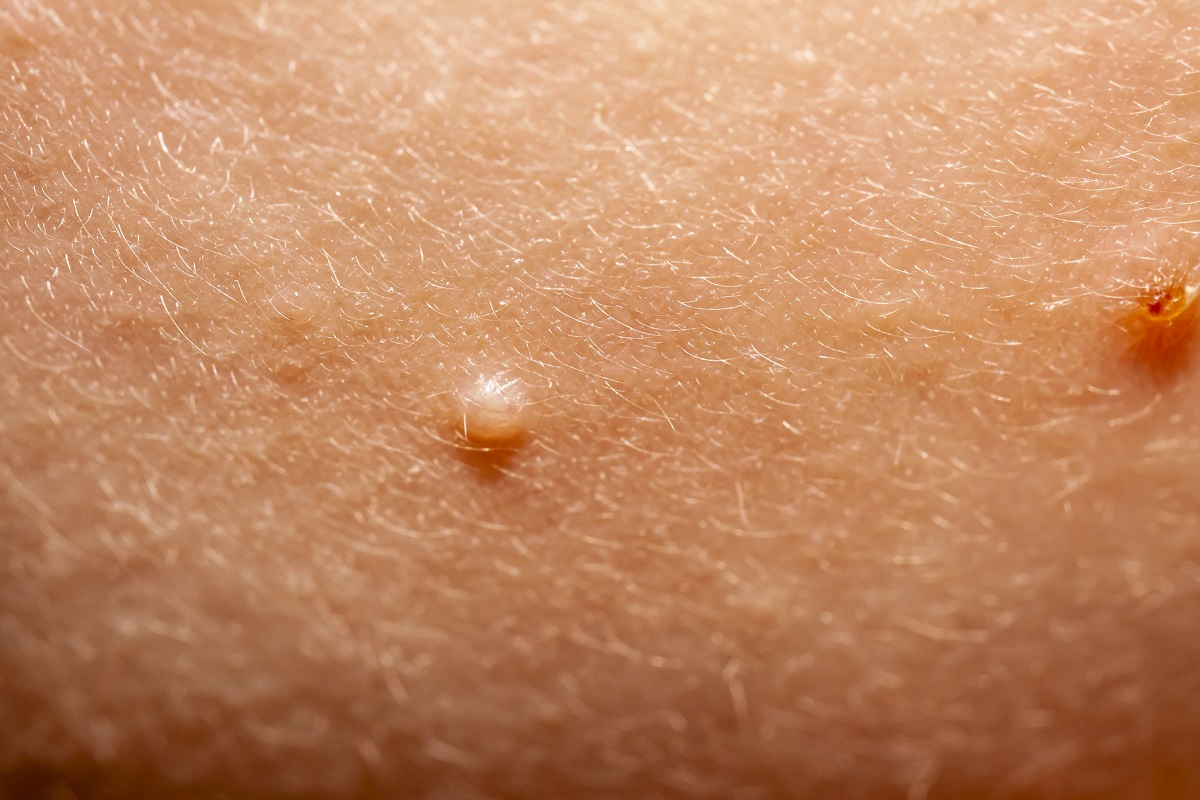
7. Anal and genital warts
The incidence of genital warts has increased in recent years due to early sexual activity and changing sexual partners.
A person suffering from a sowing of genital warts is highly infectious for transmitting the disease. A big risk is oral sex.
It can take 6 weeks to 2 years from the time of infection to the first sowing, but most often 3-4 months. Genital warts often present with burning, pain, bleeding and itching.
Anogenital warts occur at sites of increased inflammation, at the mucosal interface.
They are divided into:
- Condylomata acuminata occur in the genital and anal area, in the groin in the form of small growths of reddish or whitish colour. They enlarge over time and form cauliflower-like formations. In dry places they are whitish in colour. In moist places they are whitish on top, soft, may be slippery, swollen, with an unpleasant smell. In women they often occur on the labia and vagina. In men on the inner side of the foreskin. Their growth is rapid.
- Condylomata plana are found in the genital area on the cervix, the mucous membranes of the mouth, but also on the tongue. They are whitish flat deposits. On the tongue they may have a rough appearance.
- Condylomata gigantea resemble a tumour but rarely develop into cancer. They tend to be very large with damage to surrounding tissue. They are often found in people with weakened immunity.
Diagnostics
Examination and diagnosis is carried out by a specialist doctor, dermatologist, venereologist.
When diagnosing, the doctor focuses on anamnestic data. He obtains information about when the wart appeared, how quickly it grew, whether it has a rough surface, whether there are black dots on it.
The shape and size of different types of warts vary. They are also classified accordingly.
According to the shape, colour and location of the wart, the dermatologist can determine exactly what type of wart it is. If he is not sure, a follow-up biopsy is performed. During the biopsy, a tissue sample is taken and sent for a precise examination.
Some types of warts are found on mucous membranes. 3% acetic acid is applied to the mucous membranes to improve their visibility and subsequent diagnosis.
Course
Transmission occurs from person-to-person through direct contact or transmission from infected objects such as towels. Transmission occurs through a wounded layer of skin, from cuts, scratches, injuries, or by wetting the skin. Wet skin is more permeable to infection. The virus must penetrate to a deeper layer of skin to cause infection and subsequent development of infectious warts.
People with overt or outwardly hidden manifestations are the most infectious.
The development of the disease depends on a number of factors, such as the site of infection, the amount of infectious load, immunity and innate susceptibility to HPV infections.
With age, however, the incidence of warts decreases due to the body's immunity and recognition of the virus that the body has previously encountered.
Non-sexual warts are common in children and young people.
Anogenital warts are more common in young people who already have a sex life. They are less common in children. They can occur through transmission from an infected mother during childbirth to the fetus or through infection from a person with warts, for example, by using the same towel.
The incubation period varies. Several weeks to months may pass between infection and the first appearance of a wart.
People with weakened immunity, allergy sufferers, people suffering from eczema are most susceptible.
Transmission of warts to other parts of the body is possible. When you scratch a wart, the virus gets caught under the nail. It can spread in the nail area or spread to other parts of the body. If you bite the wart, it can spread around the lips, mouth.
The symptoms and course of some types of warts vary in shape, size and colour. Their course can be variable. Some may disappear spontaneously after a few months, others may persist for several years. They may occur singly or in large numbers. Some may also be painful.
A wart first appears as a small bump on the skin. It is soft and initially invisible because it is not too high above the skin. This bump initially has a soft and smooth surface. Later, the wart hardens, the surface wrinkles and ripples and the wart takes on its typical shape. At the same time, it rises slightly above the skin. For each type of wart, the size of the protrusion and the soreness to the touch are then individual.
A wart or a black eye?
Is it a wart or a black eye?
What is the difference between them?
A chicken eye grows inward with a hole in the middle.
A wart, on the other hand, protrudes upwards from the skin.
A cornea is a build-up of dead skin, yellowish in colour, black in the middle. It occurs on the soles of the feet, on the heels, on the sides of the toes.
Fibromas are skin growths that grow upwards and are connected to the skin only by a thin stalk. They are often found on the neck, under the armpits, on the eyelids and in areas where clothes often rub against the skin, such as under the breasts. They are not a viral disease and are not infectious or transmissible.
How can I protect myself from transmitting them and not spread them?
- Do not share towels with family members. Each family member should have their own towel.
- Wear flip-flops in communal showers and do not share shoes or socks with others.
- Do not scratch warts or try to remove them in any way.
- Do not bite your nails, stick your fingers in your mouth or bite your warts.
- Change your underwear and socks every day.
- Do not scrub wart sites with a sponge or towel to avoid irritation and cuts.
- Do not burn wart sites.
- Increase your intake of vitamins C, E and B to boost immunity.
Warts in pregnancy
Genital warts are the most common threat to mother and baby during pregnancy.
During pregnancy, there is no risk of transmitting the virus to the fetus.
The foetus can only become infected during birth by passing through the infectious birth canal. In the case of warts on other parts of the body, the risk of transmission to the foetus is lower and the risk of transmission at birth is virtually non-existent.
Genital warts are recommended to be removed before childbirth. Home treatment is not the right solution.
Cauterisation with liquid nitrogen with local anaesthesia is primarily carried out by a specialist doctor.
The problem is with internal warts, which must be cauterised under general anaesthesia. This is a problematic procedure.
There is a danger if the warts grow so large that they could block the birth canal. In addition, the virus can penetrate the baby's larynx during birth and cause breathing difficulties.
In most cases, warts disappear from the mother's body after childbirth because the body's immunity is strengthened.
Home treatment
Are you worried about warts and wondering how to remove them?
In addition to conservative treatment with various medical products, homeopathic remedies, herbs or various home recipes can also be used. There are several options. But with home treatment, you must be sure that it is a wart and not another skin disease.
There is no guaranteed home remedy for warts. But there are some interesting procedures that people praise on internet forums.
Putting a banana peel on the wart every night for a week can help you get rid of warts.
Similarly, garlic can be used at night. It is sliced and stuck directly on the wart with a plaster. Another method is crushed garlic. Crushed garlic is rubbed on the wart and left on for 4-5 hours.
Lemon and vinegar can also help.
Cut the rind of a lemon into small cubes, about the size of the wart, put them in a jar and pour vinegar over them. You can also use 5% apple cider vinegar to make sure the cubes are completely covered with vinegar. Cover the jar and let it stand for 24 hours. You can use the rind prepared in this way for up to 48 hours.
Rub the area around the wart with cream or petroleum jelly to protect it from the solution. Apply the prepared bark to the wart at night. Leave it on overnight. Apply the bark every night until the wart darkens and turns black. After it turns black, wait until the wart falls off. Do not cut it off yourself.
This treatment is suitable for common, plantar warts and warts on the feet.
Urinotherapy is rubbing the wart with mid-morning urine until it disappears. This treatment can take up to two weeks. It is suitable for plantar and flat warts.
Baking soda. Make a slurry of baking soda mixed with water. Rub the slurry on the wart and cover with a plaster. It can be used during the day or overnight.
You can also loosely rub the wart with onion or use onion ointment. Castor oil is also used for rubbing.
Herbs for warts
Herbs are also helpful for warts. Herbs have always been used because of their healing effect.
Swallowwort is an excellent helper in the treatment of warts. The juice of fresh swallowwort flowers is rubbed on warts in the form of yellow milk. You can also use a tincture of swallowwort.
Other options are to use tincture of mountain arnica, calendula juice, tea tree oil, aloe vera.
In several folk recipes, propolis is also mentioned, which is applied to the wart and then sealed with a patch.
However, be careful when self-medicating. Not every plant helps.
If you do not know how to deal with the above-mentioned home treatments or herbs or natural products, you should see a doctor.
How it is treated: Warts
Treatment and medication: how to get rid of warts, what will help remove them?
Show moreLaser wart removal
Gallery




Warts is treated by
Other names
Interesting resources










